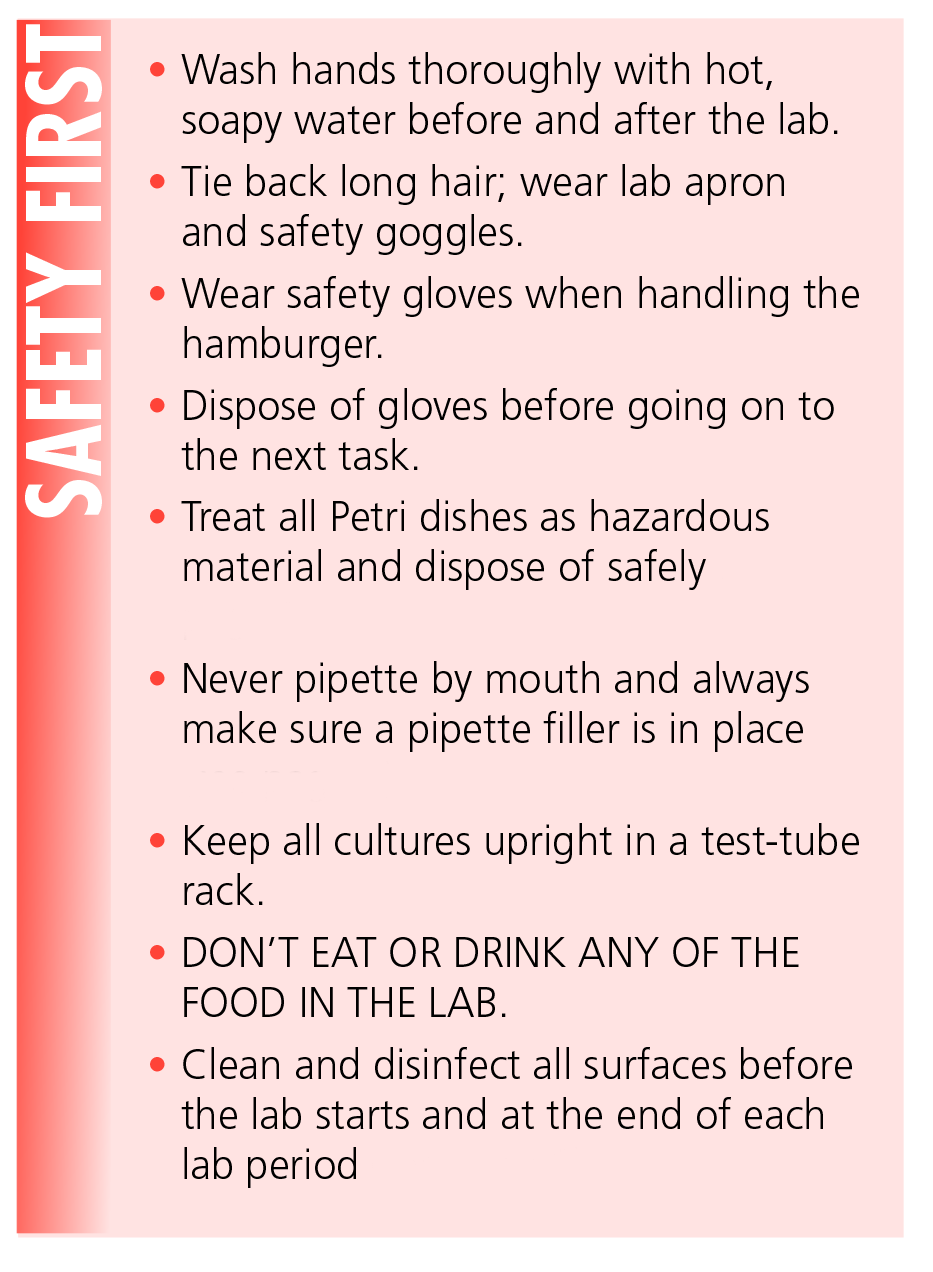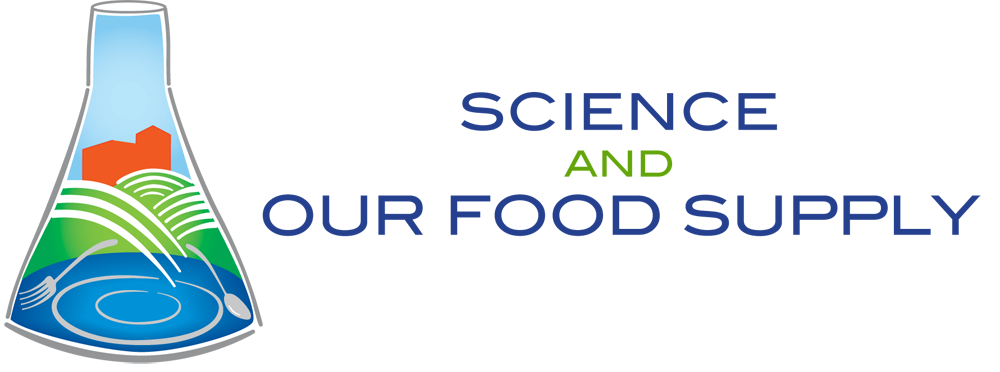Agricultural Literacy Curriculum Matrix
Lesson Plan
Coliform Counts
Grade Level
Purpose
This is an advanced level or honors lab. During this investigation, students will perform a coliform analysis of raw hamburger meat. They will collect, organize, and interpret data while practicing safe lab techniques. In the end, they will apply the results of a coliform analysis to food safety. Grades 9-12
Estimated Time
Materials Needed
For the Class
- .25 pound (113 grams) of ground beef (ground chuck or other inexpensive cut of beef is best)
- Safety gloves
- Safety goggles
- 1.5 or 2 L flask
- Violet red bile agar (VRBA)
- Sterile spatula or tongue depressor
- Sterile aluminum foil for weighing the samples
- Burner to heat agar
- Scale
- 90 ml of sterile saline solution (you can buy it inexpensively at a pharmacy)
- Blender (sterilize bowl, if possible)
- Copy of the Student Lab Sheet: Coliform Counts for each student
For Each Team
- 5 sterile Petri dishes with violet red bile agar and covers — 4 for the hamburger, and 1 for the control dish
- Parafilm
- 3 sterile test tubes
- 27 ml of sterile saline solution
- Test-tube rack
- Permanent marker
- 4 sterile, disposable 1 ml pipettes with pipette bulbs, or 4 sterile 1 ml tuberculin syringes
- Thermal gloves or hot pads to handle hot flasks
Advance Preparation
- Obtain the violet red bile agar in powder form.
- Make sure that all the materials and equipment are available for the lab.
Vocabulary
coliform: a bacteria commonly used as an indicator of sanitary foods and water
food safety: the practice of handling, preparing, and storing food in a way that prevents food-borne illness
Background Agricultural Connections
The presence of coliforms in food does not mean that the food is not consumable — it means that proper precautions must be taken to reduce their presence in the food before it is eaten.

Coliforms are bacteria of great concern because they indicate the potential presence of pathogenic microorganisms such as Cryptosporidium, Salmonella, or Giardia. They can be found in untreated water and find their way into food from fecal contamination resulting from unsanitary processing conditions or human food handlers. Coliforms are not disease producers themselves, but they indicate that food may have been contaminated with fecal contamination, which may contain pathogens. They are also normal constituents of plant products.
Sometimes there are as many as 104 to 106 coliforms in 1 gram of hamburger.
Note: Please be sensitive that some students can be really turned off from eating hamburger if we overstate the case and alarm the students unnecessarily. We have all eaten hamburgers and enjoyed them and we are all okay! You might remind the students that hamburgers purchased at most fast food franchises are carefully cooked and safe to eat.
Bile salts inhibit the growth of gram-positive bacteria. This reduces competition and allows the gram-negative bacteria, which are the coliforms, to grow more readily.
Neutral Red is a dye, which acts as a pH indicator. (Coliforms give off CO2, which combines with water to form carbonic acid which causes a color change in the agar. So, the color change indicates their presence.)
Crystal Violet allows coliforms to grow by inhibiting gram-positive bacteria. If the students see a halo around a colony, it’s likely to be bile precipitate.
Science and our Food Supply Modules
This lesson was developed as a portion of an entire unit of lessons focusing on food safety from farm to table. Use the following links to see the remaining lessons:
Module 1: Bacteria
Module 2: Farm
Module 3: Processing and Transportation
- Blue's the Clue: Souring Milk for Science
- Mystery Juice
- Irradiation Web Quest
- Ultra High Pressure Treatment
Module 4: Retail and Home
- Fast-Food Footwork
- Cooking Right: The Science of Cooking a Hamburger
- Coliform Counts
Module 5: Outbreak and Future Technology
Evaluation
Engage

- Introduce this experiment by asking, "Has anyone ever heard about coliforms and how they might relate to food safety? This advanced-level lab will lead us down a new and intriguing path that scientists take to analyze a food, such as hamburger, to determine if it might be contaminated with pathogens. Let’s get started and see what coliforms are and if they really count!"
- Remind students of good lab techniques and procedures (see Lab Procedures handouts).
- Also remind them that most hamburgers are safe to eat. However, once in a while some bad bacteria show up in hamburger. If you haven’t already done so, discuss with the students why hamburger is so special in terms of bacterial content.
- Emphasize that there could be harmful organisms growing in the Petri dishes.
- Introduce students to why detection of coliform bacteria is important (see information found in Background Agricultural Connections).
Explore and Explain
Part 1: Teacher Demonstration
- Divide the class into teams of 4 students each.
- Distribute Student Lab Sheet: Coliform Counts to each student.
- Have students assist with the preparation of the VRBA and hamburger solution.
Preparation of the Violet Red Bile Agar (VRBA)
- Prepare the VRBA as per instructions on the label.
- In a flask, add 41.5 grams of agar to 1 L of water (use the best water available, e.g., distilled, etc.)
- A general rule is that it takes about 20 ml per Petri dish. This will tell you about how many ml of agar to prepare.
- Once you have the VRBA agar in the flask, bring it to a slow boil. Make sure the agar is at a rolling boil. Be very careful, as it can flash boil over the top very quickly.
- The agar should be translucent with no undissolved granules of agar on the sides of the flask.
- Cool the agar slightly. Caution: It will harden if cooled too long. Monitor the agar temperature as it cools. The best temperature for pouring is 111–115° F (44–46° C). A water bath set at this temperature would be ideal.
Preparation of the Hamburger Solution
- Add 90 ml of sterile saline solution to the blender.
- Weigh out 10 grams of hamburger on sterile aluminum foil. (Wear safety gloves.)
- Add the hamburger to the sterile saline solution in the blender. Blend for about 1 minute on high. The concentration of the hamburger is 1 in 10.
Part 2: Student Activity
Have Each Team of Students:
- Prepare Test Tubes and Petri Dishes
- Label 5 Petri dishes on the bottom: “10,” “100,” “1,000,” “10,000,” and “control.”
- Set up 3 test tubes and label them: “100,” “1,000,” and “10,000.”
- Add 9 ml of sterile saline solution to each of the 3 test tubes.
- Inoculate Petri Dishes (see Student Lab Sheet: Coliform Counts)
- 1 in 10
- Pipette 1 ml of the 1-in-10 hamburger solution directly into the Petri dish marked “10.”
- Carefully swirl the dish to cover the surface. Cover the Petri dish.
- 1 in 100
- Pipette 1 ml of the 1-in-10 hamburger solution into the test tube marked “100.” Now the concentration of the hamburger is 1-in-100.
- Thoroughly mix the solution by holding the test tube by the top and gently striking the bottom with the finger on the other hand for about 5 strikes.
- Pipette 1 ml of this solution into the Petri dish marked “100.”
- Repeat this procedure for the 1-in-1,000 and 1-in-10,000 dilutions.
- Have students draw the dilution and plating scheme in their food safety portfolios.
- 1 in 10
- Add the Agar to the Petri Dishes Containing the Hamburger Solutions
- Help the students learn to properly pour the agar out of the flask into the Petri dishes. Show them how to flame the mouth of the flask.
- Pour about 10 ml of agar into each Petri dish containing the hamburger solution and then swirl the dish to mix and evenly cover the bottom of the dish.
- As soon as the agar is solidified, pour in another 4 to 6 ml of agar and swirl again to spread evenly.
- Pour a control dish to make sure the agar is not contaminated.
- Store the dishes upright until the agar is solid. Then invert the dishes, seal them with Parafilm, and place in the incubator at 95° F (35° C) or let the dishes sit at room temperature (away from the sun) overnight. Examine the Petri dishes for growth the next day and record observations.
- Record Data
- Students should examine the sealed Petri dishes for the presence of colonies. Remind them to be sure that when counting the colonies, they multiply by the dilution factor. This should give relative numbers of coliforms in the hamburger.
- Students should report their findings to the class for analysis and discussion.
Evaluate
Review the following questions:
- What is the purpose of the control dish?
- Which concentration of the hamburger dishes was the easiest to count? Why?
- What was the purpose of this lab? Write a paragraph about how the lab relates to reducing foodborne illness.
- What should be done to ensure that the hamburger is safe to eat?
- What do you think is the source of coliform bacteria in the meat?
- Do you think that pathogens make you sick every time you eat them? Why? Why not?
- List 10 other foods that you would like to test for coliform bacteria. Explain why you chose each food.
- What do you think the coliform count would be for raw oysters and sushi?
- Do you think fresh strawberries would be high or low in coliforms? Explain.
Summarize by concluding with students that testing for the presence of coliforms is one way food scientists can check for possible contamination of food. The presence of coliformsin food indicates the potential presence of pathogenic microorganisms, and means that proper precautions must be taken to reduce their presence in the food before it is eaten.
Acknowledgements
The Science and Our Food Supply Curriculum was brought to you by the Food and Drug Administration Center for Food Safety and Applied Nutrition and the National Science Teaching Association.
- FDA Education Team Leader Food Safety Initiative: Marjorie L. Davidson
- FDA Science and Our Food Supply Project Director: Louise H. Dickerson
- FDA/NSTA Associate Executive Director and Science and Our Food Supply Program Director: Christina Gorski
- FDA/NSTA Science and Our Food Supply Program Assistant: Jill Heywood
Recommended Companion Resources
Author
Organization
| We welcome your feedback! If you have a question about this lesson or would like to report a broken link, please send us an email at matrixelearning@gmail.com. If you have used this lesson and are willing to share your experience, we will provide you with a coupon code for 10% off your next purchase at AgClassroomStore. |
Agricultural Literacy Outcomes
Food, Health, and Lifestyle
- Provide examples of foodborne contaminants, points of contamination, and the policies/agencies responsible for protecting the consumer (T3.9-12.h)
